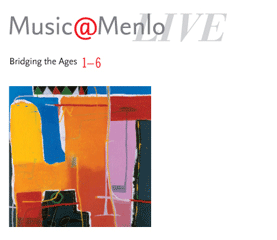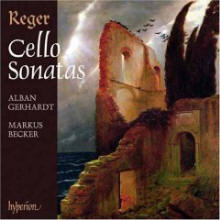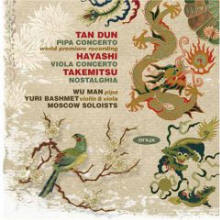|
You are reading the older HTML site Positive Feedback ISSUE march/april 2008
Notes of an Amateur - March, 2008, Part 2
Music@Menlo Live, 2007: Bridging the Ages (Recordings from the 2007 Music @ Menlo Festival, Palo Alto, California) At the end of the last shelf of a great many classical CD collections these days is a growing collection of 'live' recordings of concerts and festivals, because these days in particular, it's on records of 'live' music-making where a great many of the most exciting musical performances are found. The largest single group of 'live' CDs in my collection has become the recorded proceedings of Wu Han's and David Finckel's annual Music@Menlo Festival. This year's six-CD set is the fifth produced so far. And I am pleased to report that both musicianship and sound (by inimitable recording engineer Da-Hong Seetoo) remain superb. The pedagogical point of the 2007 series, if I read it right, is to get the audience out of the traditional historical mindset many of us bring to classical music listening. Part of what we do when we learn about a piece of music is to domesticate it, rob it of its natural force as a unique work. I include myself here. We put it into a period or movement, which gives us one kind of knowledge; but this can also rob us of another kind. "Bridging the Ages" is constructed of programs that juxtapose works from different periods such that we are led (or at least urged) to disconnect them from their usual contexts and associations and hear them synchronously—that is, as if they are of the same moment and place: now and here. (This is how especially literature was taught in the 1950's in an effort to get students to focus on the texts rather than their cultural and social milieu.) It is an approach that has its virtues, but program design doesn't matter a twit if the performances aren't good; and all of them in this set are, some spectacularly so. The Miami Quartet's Schubert's Death and the Maiden String Quartet, D. 810 reveals what can happen if musicians set aside this famous quartet's supposed theme and just play the hell out of it. I have never been much moved by this chamber chestnut—it has always struck me as overly dramatic and indulgent. My problem, I'm sure. The Miami musicians up the tempo and let its, at least to my ears, latent life out. Jan Swenson (violin) and Gilbert Kalish (piano) give us a masterly and magnetic performance of Ravel's Sonata for Violin that's at least as good as any I've heard. It leaves me with nothing to say, just I'll just put it on again! And then on a single disc, Carol Wincenc (flute), William Bennett (oboe), Corey Bell (clarinet), William Vermeullen (french horn), and Dennis Godburn (bassoon) perform Ravel's over-performed Le tombeau de Couperin in an arrangement by Mason Jones that makes it absolutely new and captivating; and Wincenc, Bell, Swensen, Joseph Swenson, Masao Kawasaki (viola), Ralph Kirschbaum (cello), Florian Conzetti and Christopher Froh (percussion), Daxun Zhang (bass), and Wu Han and Inon Baranatan (pianos) deliver a chamber version of Saint-Saens' Carnival of the Animals that transforms the work from children's toy into an irresistible sonic tour de force. Putting the Ravel work and the Saint-Saens on the same recording with a concerto grosso by Handel and a cantata by Bach, both state of the performing art, may make the festival's instructional point: it is entirely possible that in addition to being brilliant performances, the freshness of the Ravel and Saint-Saens works seems even fresher in the presence of Handel and Bach. And the Bach and Handel also sound surprisingly new. While virtually everything in the festival programs each year has something memorable about it, it is for brilliantly idiosyncratic performances like the Schubert, the two Ravels, and the Saint-Saens that I come to Music@Menlo. This the kind of music making that seldom makes it onto records because, as both pianist Susan Tomes in Beyond the Notes and scholar Robert Philip in Performing Music in the Age of Recording tell us, musicians just play differently before recording microphones and in an empty venue. They tend, despite their best efforts, to hold something inventive and exploratory back, they suppress whimsy and inspiration. They are reluctant to just let it fly. The musicians of Music@Menlo let it fly. Other notable musicians who play in the series include Finckel (cello), Christopher Nomura (baritone), Philip Setzer (violin), Paul Neubauer (viola), Colin Carr (cello), Kenneth Cooper (harpsichord), Jason Vieaux (guitar), Adam Barnett, (violin), Wu Jie (violin), Pierre Lapointe (bass), Adam Janss (cello), Heidi Grant Murphy (soprano), Kevin Murphy (piano), Erin Keefe (violin), Gary Graffman (piano), Andrés Diáz (cello), and The Escher Quartet. Better make room at the end of the shelf. These recordings are only available at www.musicatmenlo.org.
Max Reger, Cello Sonatas. Alban Gerhardt, cello; Markus Becker, piano. Four Sonatas for Cello and Piano; Three Suites for Solo Cello. Hyperion CDA 67581/2. Max Reger writes a turbulent kind of romanticism in his sonatas for cello and piano, which sometimes sound like Rachmaninoff without the rapture or just with more complex emotions; and sometimes, when the turbulence subsides, like a modern version of Brahms. It is as if Reger is looking for a way to speak musically about modern attitudes and feelings but to retain the romantic idiom he has presumably grown up with. To represent complex emotions without modernist style is a formidable challenge. A number of late nineteenth century English novelists and poets tried the same thing: George Meredith's narrative sequence of poems called Modern Love, and Thomas Hardy's novels are prime examples. The musicians here seem to understand and appreciate Reger's effort. Here is cellist Gerhardt, speaking for both himself and pianist Becker:
This is harder music to enjoy than Brahms and Rachmaninoff. The "incredible serenity and beauty" that Gerhardt writes of is there but it always turns itself inside out before long, into something that feels like restless (and relentless) self-criticism. Pure melody is never to be trusted, for long. This makes the music more interesting than engaging: you really do have to stay 'on it' to enjoy it. But to my ears (and brain), it has more substance than especially his exact Russian contemporary Rachmaninoff. And if you're a cello freak as I am, this music should be a part of your experience—and it will grow on you. And the cello and piano sonatas are not the only music in this CD set—there are three suites for solo cello that seem to come from another world, certainly from another place in Reger's brain. A baroque place, which is also where he went for his wonderful Sonatas for Unaccompanied Violin. (There is a great pair of CDs of the violin sonatas by Ulrike-Anima Mathé on Dorian, which while out of print is available through Amazon.) Though Reger's works for solo cello (and violin) is less constrained than Bach's, they are clearly intended to call up Bach's work. It is as if the protégé is calling out and playing for his master—and each successive cello suite calls him out farther! This is the music that drew me to this recording and I have not been disappointed. All three suites open in a deliberate, Bach-like style but soon become less formal and more adventurous and free-ranging. They both gain and lose from this strategy, but especially without a piano to argue with, become more single-minded than the sonatas. There are moments of beauty and reflection; moments of songfulness; moments of play, dancing and prancing; and moments of outright vigorous and rambunctious exercise. But even amidst the variety of moods, there is a restfulness about this music. I get the sense that the solo suites were an escape for Reger. And by the time we reach the third suite we are a long way from Bach. I have grown nearly as fond of these suites as I am of the sonatas for solo violin. The musicians are able—Gerhardt strikes me as a fine interpreter of Reger—he has not read too far between lines, as some others might be tempted to do. And the sound seems excellent. There is no information given about the recording site or personnel, but presumably this is an all-German project. As a whole, this album is a brave and fruitful venture.
Tan Dun: Pipa Concerto; Takemitsu, Nostalghia; Hayashi, Viola Concerto. Yuri Bashmet, viola, Moscow Soloists. Onyx 4027. Between the terrains of classical music on the one hand and popular music (including folk, blues, and jazz) on the other lies a broad area which includes movie sound tracks, light classical music, and 'mood music.' Music that in some cases is written to support something else (film, TV series primarily) or music that is written so that other things can go on while it's being played (chatting, eating, shopping, meditating, going up and down in elevators). What distinguishes it primarily from both popular and classical music is that for many of us it is difficult to listen to as an end in itself. Even the soundtracks we like (Victory at Sea, Twin Peaks) work by recalling their films and shows—though I challenge you to sit through a really long one! (Ballet music escapes this terrain because it generally has musical interest of its own, though not all ballets pull this off.) Occasionally this 'dependent' or 'background' music aspires to be more: its composers attempt to reach from classical toward popular in a (misguided?) belief that they can increase the audience for the latter thereby. Tan Dun and Toru Takemitsu have been major figures in this field for a long time. Both are justifiably famous for their soundtracks (Dun: Croaching Tiger, Hidden Dragon; Takemitsu: Black Rain). But both have also written what they intend to be serious classical music: music that can stand alone. This recording has a concerto by each along with excerpts from three of Takemitsu's film scores; and there is a viola concerto by a third composer, Hikaru Hayashi, who has a huge track record in both classical and film music. I will confess up front that I have always had trouble with music such as this, as you have no doubt gathered from my tone so far! I was drawn to this CD by world-renowned violist Yuri Bashment and the Moscow Soloists. I figured that if Bashmet was able to take this music seriously, who was I to play the snob? I have trouble with this kind of music because what I hear mainly from it is an absence: nothing reaches out to us and asks to be attended to. I find myself fidgeting. Neither my brain nor my emotions are engaged so what else can I do? I did not pre-judge the music on this recording—I found myself actually rooting for it—I admire Bashmet a great deal. But I did fidget. A lot. I like popular music because it expresses, finds a form for, our basic emotions: nostalgia, sentimentality, desire, rancor, pathos, sadness, humor. I like classical music because it makes something more (something different) of all of these basic emotions, something interesting: tragedy, comedy, elegy, irony, romance, dance. This is a crude distinction but what lies behind my fumbling prose is a real one. And the problem is that there is nothing between an effective expression or embodiment of basic emotion and tragedy, elegy, and the rest. Except noodling around, trying not be either or neither or both: music that is reluctant to express real emotion or afraid to become too interesting or too complex. When it tries to make popular music more classical it generally turns emotion into stuffy cliché; when it tries to help classical music go down easier, it makes something thin, too sweet, and without calories. When it tries to be both, it just gets confused. And the principal problem with music like this for a reviewer is that it induces him to give a long lecture like this rather than talk about the music because he can find nothing to say about it! But let's give it a try. Tan Dun's Concerto for Pipa (a Chinese lute-like stringed instrument) and String Orchestra is vigorous, Chinese in its affect, and highly atmospheric—with the fascinating pipa much in the foreground, played with what sounds like extraordinary dexterity. The mood of the work is melodramatic, sensational, and balletic, sounding very much like a film score without its film. From time to time it feels like Chinese Copland (Billy the Kid, Rodeo), though to be fair Copland's ballets work very well without their dancers. At the end of the second movement, the orchestra pretends to retune itself, thereafter becoming less Chinese and more Western in its harmonies for the following Adagio movement, which is full of the sound and spirit of Samuel Barber's Adagio for Strings, though in fact it's a Bach prelude from the Well-Tempered Clavier. It finally becomes Chinese in mood again, welcoming in the pipa which has been silent during the earlier part of the movement. The final movement takes us back to the mood of the opening, though it is sonically more interesting, with the pipa playing first against the low strings and then against the whole string orchestra. A series of cadences in the low strings leads us toward the finale, succeeded by the more plaintive sound of the pipa alone. This concerto is not unlike other Tan Dun music I've heard: it has many surface delights and diversions and much sonic drama. But it does make one long for filmic completion. It's all whirling around something that's not there. Takemitsu's Concerto for Violin: Nostalghia has an entirely different mood but again seems to be about something that is not present in the music itself. It moves around, works its way up to, an absence. To be fair, it is an elegy—for the Russian filmmaker Andrey Tarokovsky. So at least in theory, there is a presence. But elegies don't work this way: they offer up a musical equivalent to what or who is lost. So again, as a listener, I am put in the position of …well waiting and fidgeting. For something to arrive. Which never does. Hayashi's Concerto for Viola is the most listenable of the works in the program as classical music (though it is interesting to read in the notes that in addition to having composed a considerably body of classical music, Hayashi has done over 80 film scores.) But even this piece has a good deal of noodling in it. There is another kind of 'background' music that I haven't said much about, music that has given rise to a lot of what we now call New Age music. Music that is content with creating a passive state of being. At its least interesting it is simply 'mood music,' at its most ambitious it is ambient or minimalist music, or like Hayashi's concerto. The dependency this music has is on our need to simply rest or meditate (or make out). It aims to help us do these things rather than draw our interest to it. Needless to say, all of this music is Asian, though I have the sense it often strives not to be: that is, to reach out to a Western audience with traces of Asian mood or color. Which is to say that I don't think my disappointment here is a failure to respond to its Asian-ness. And finally, I feel the need to say that I like film music. (I hate light classical and mood music.) I can't imagine some of my favorite films without their music. Even John Williams gives me a thrill now and again, especially in Harry Potter I. But by itself, except as an aid to recalling films, for me it simply has no musical life. Take this all with as much salt as you like, especially if you're a film-score buff. If you're one of these, you may well like this music a lot and decide that I am a hopeless snob fighting against honorable efforts to bridge musical terrains. System used for these auditions: Audio Note CDT3 transport and Dac 4.1 Balanced Signature; Blue Circle SBT/SBM separates; Blue Circle BC6000 line conditioner; Jean Marie Reynaud Duet speakers; Audio Note Sogon and AN-Vx interconnects and Audio Note Lexus speaker cable. Bob Neill, in addition to being an occasional equipment and regular music reviewer for Positive- Feedback Online, is also proprietor of Amherst Audio in Amherst, Massachusetts, which sells equipment from Audio Note, Blue Circle, Manley Labs, and JM Reynaud, among others.
|



